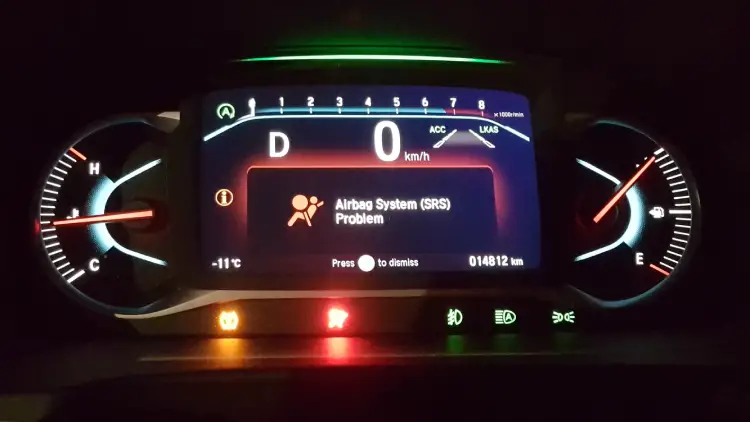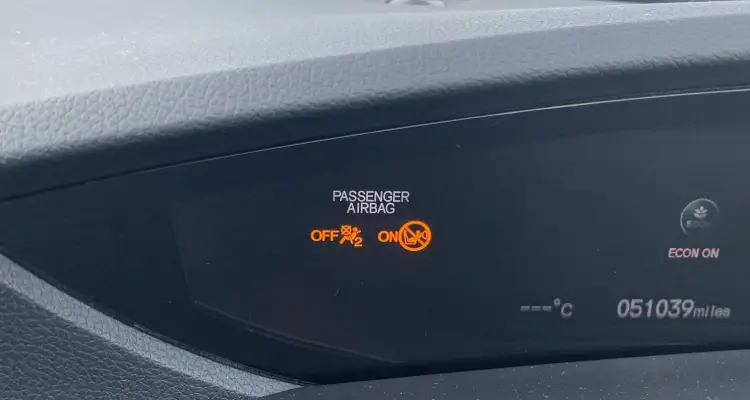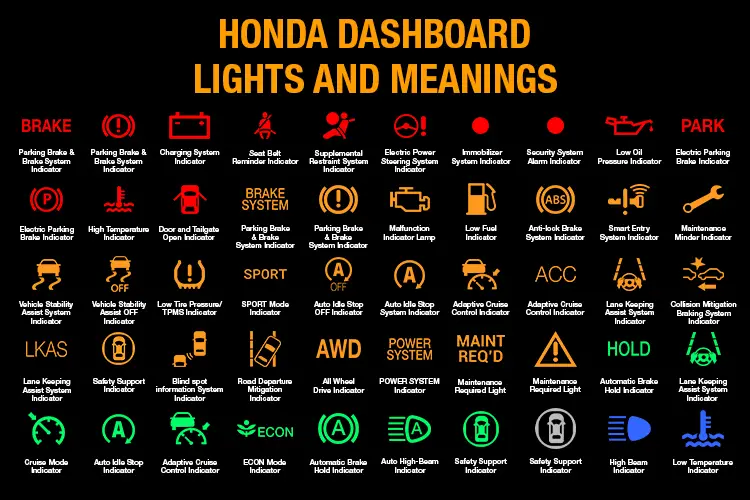You’ve likely known or seen the SRS light on your Honda’s dashboard, but have you ever wondered what causes it to illuminate?
This article delves into the triggers behind the SRS light and offers insights on how to address this light effectively.
Get ready to uncover answers to your burning questions about your Honda’s SRS light in the following sections.
What Does Honda SRS Light Mean?
SRS stands for “Supplemental Restraint System”, which refers to the airbag system designed to enhance vehicle safety during collisions. Here’s what you should know about the SRS light in your Honda:

- Normal Operation: When you start your car, the SRS light will briefly come on and then turn off. This indicates that the SRS is functioning correctly.
- Watch for Warnings: If the SRS light illuminates at any other time or you see the “Supplemental Restraint System Problem See Your Dealer” message on your driver information interface, there’s an issue with your airbag system. Prompt inspection and repairs are essential to ensure your airbags and seat belt tensioners work when needed most.

Sometimes, you may notice the Passenger Airbag Off light. This informs you when the passenger’s airbag has been deactivated, typically when the passenger seat is empty or when weight sensors detect a small child or infant in the passenger seat.
It is important to be aware of the status of this indicator to ensure the safety of your passengers and make appropriate adjustments as needed.
Can You Drive With the SRS Light On?
Yes. While it’s technically possible to drive with the SRS light on, it is strongly discouraged. When the SRS light is on, it means that the airbag system may not function correctly in the event of an accident, increasing the risk of injury in a crash. It’s advisable to have the issue diagnosed and repaired by a qualified mechanic as soon as possible.
However, you can use a Honda-specific scan tool to self-diagnose the cause of the SRS light. This tool communicates with your Honda’s onboard diagnostic system, providing detailed insights into the specific issue. Using such a tool not only enhances the accuracy of diagnosis but also saves time and money by identifying the problem more quickly and accurately.
Tool
What Would Cause the SRS Light to Come on?
Seat Belt Buckle Failure
This is considered the most common cause. Related problems, such as a faulty switch, dirt, debris, or damage to the buckle, can interfere with the seat belt’s operation and trigger the SRS light.
To resolve seat belt buckle issues, clean it to remove dirt and debris or consider replacing the buckle if needed.
Malfunctioning Sensors
Several sensors are integral to the proper functioning of the SRS system, including:
- Driver’s seat position sensor
- Weight sensors in the front passenger’s seat
- Impact sensors
- Rollover sensor, and more.
If any of these sensors malfunctions, it will send incorrect signals to the SRS control module. For example, if the weight sensor indicates a passenger when there isn’t one, the system might disable the airbag for that seat, leading to an SRS warning.
When you suspect a malfunctioning sensor, diagnose the specific sensor problem and replace it if necessary.
Faulty Electronic Control Module (ECU)
The ECU, or airbag control module, is responsible for monitoring and controlling the SRS system. For example, when the vehicle decelerates suddenly, the sensors send information to the control unit, which signals airbags to inflate.
If the ECU itself malfunctions, it can trigger the SRS light. However, ECU failure is typically less common than issues with sensors or other components.
Wiring and Connector Problems
Damaged or corroded wiring, loose connectors, or poor electrical connections within the SRS system can also lead to SRS light activation.
Accident or Impact
If the vehicle has been involved in a collision or experienced a strong impact (even if the airbags didn’t deploy), it can trigger the SRS light.
After a collision or strong impact, have the vehicle inspected by professionals who can reset or repair the SRS system as needed.
Aftermarket Accessories
Installing aftermarket seats, seat covers, or making modifications to the vehicle’s interior can interfere with the SRS sensors and cause the light to come on if not done correctly.
How to Turn off the SRS Light On Honda
It’s important to address the underlying issue causing the light to come on rather than simply turning it off. Attempting to disable the SRS light without resolving the problem could compromise your safety in the event of an accident because the airbags may not deploy correctly. Here’s what you should do to address the SRS light:
Step 1: Diagnose the Cause
If you suspect any of the mentioned common causes, start with it. However, you should invest in a Honda-specific scan tool to pinpoint the problem.
- Plug the scanner into the OBD-II port under your dashboard.
- Turn on the ignition (engine off).
- Power up the scanner.
- Select the “Read Codes” function.
Once you’ve got the codes, refer to the Honda SRS airbag codes list below to interpret them.
Step 2: Repair or Replace Faulty Components
Once you’ve identified the problem, take the necessary steps to repair or replace the faulty components. This may involve fixing a malfunctioning sensor, replacing a damaged seat belt buckle, or addressing other issues.
Step 3: Clear the SRS Codes
After the necessary repairs or replacements have been made, the SRS codes need to be cleared from the vehicle’s computer system.
Again, use the scanner to clear the codes and reset the SRS system.
While some DIY methods for resetting the SRS light may be available, attempting them without proper knowledge and experience can have risks. It’s important to exercise caution and ask a qualified technician or a Honda dealership for help.
What’s Next?
Now that you’ve unraveled the mysteries of your Honda’s SRS light and how to handle it, we’d love to hear from you.
Have questions or insights to share? Leave a comment below and join the conversation about enhancing safety on the road. Your input matters!



Recommended for you
DRL Light on Honda: Meaning and How to Respond
What Does Wrench Light Mean on Honda? How to Reset it?
Some Driver Assist Systems Cannot Operate: Meaning and How to Fix